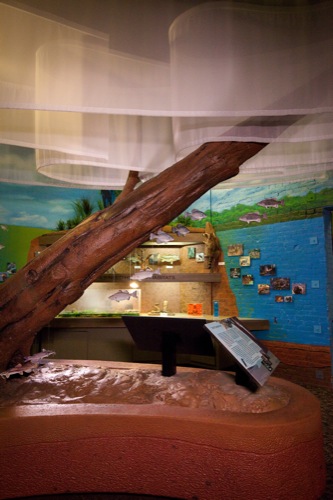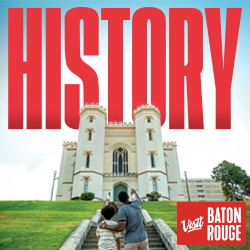
Courtesy Paducah CVB
Paducah’s history is closely tied to rivers. Situated on the banks of the Ohio River at its confluence with the Tennessee River, Paducah is also near the Cumberland River and the Mississippi River and is the economic center of the Four Rivers Region.
The River Discovery Center uses artifacts, photographs and interactive exhibits to tell the human and geological history of the Four Rivers Region. You can find out about all the types of boats that have plied the rivers; learn about the lifecycles of mussels, which once supplied a vibrant button industry; see a simulation of the 1937 Ohio River flood; and learn about hydroelectric power at a large-scale-model river dam.
Listening stations provide access to the museum’s rare collection of songs sung by the roustabouts who provided the hard manual labor on 19th-century riverboats.
“They are songs about work and life on the river,” said E.J. Abell, the museum’s group coordinator. “It was very hard work.”
As I listened to a song written by Stephen Foster about the Glendy Burke, the lyrics of which include the line “the boat was fast and so was the captain,” Abell said with a laugh, “It provides information that might not have been written down anywhere else.”
The most popular area is a simulator that lets you pilot a virtual tugboat or speedboat along the stretch of river by downtown Paducah.
Abell will do arts projects or educational presentations for small groups that have the time.
Housed in downtown Paducah’s oldest building, an 1843 former bank building, the River Discovery Center is directly across brick-paved Water Street from a section of the floodwall murals that depicts scenes from Paducah’s river industry history.
Also housed in a historic building is the Civil War Museum, whose artifacts, photographs and documents are arranged in an interesting and informative fashion throughout the antebellum house that was once the home of Confederate Gen. Lloyd Tilghman, who was killed at Vicksburg.
“It is one of only seven houses of former Confederate generals that are preserved,” said Bill Baxter, a retired U.S. Air Force colonel who is the museum’s administrator.
The museum includes an accurate model of Fort Anderson, which was carved out of the banks of the Ohio River in downtown Paducah by Union troops under the command of Gen. Ulysses S. Grant and later withstood an attack by Confederates led by Gen. Nathan Bedford Forrest.
The river gradually obliterated the fort’s site following the war, and a spoon on the wall above the model is the only known artifact from the fort.
Another innovative use of a historic structure is the Whitehaven Welcome Center on Interstate 24. In addition to a welcome center, the restored 1860s mansion has memorabilia of Paducah native Alben Barkley, who was the majority leader of the U.S. Senate and vice president of the United States under President Harry S. Truman.










